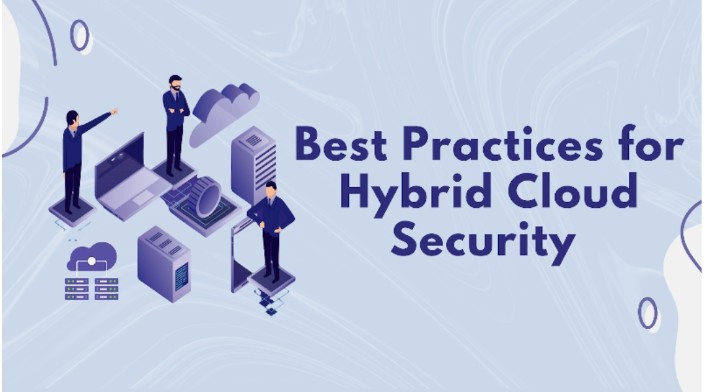Technology
10 Expert-Recommended Practices for Hybrid Cloud Security Management

Introduction
A significantly more effective model has appeared on the horizon in the form of the hybrid cloud as an answer to the question of how to possess scalability and flexibility while maintaining effective control over the organization’s resource usage. Organizations should use private and public cloud structures, which help minimize costs and improve efficiency. However, this structure brings different security complexities to the table. Security amid a hybrid cloud was once a luxury that could be ignored; it has become necessary. Hybrid Cloud Security Management protects INFO from security breaches, legal non-compliance, and new threats from cloud vulnerabilities.
In this guide, you will discover 10 best practices for handling key issues of hybrid cloud security management suggested by experts to maximize the benefits of using a hybrid cloud architecture at your business.
Understanding the Complexities of Hybrid Cloud Security
Hybrid cloud security challenges stem from the diverse nature of these environments. Common pain points include:
1. Lack of Control and Visibility: It is often challenging to fully control and monitor hybrid cloud environments. To manage security properly, networks and systems are spread across various providers and organizations, leaving gaps in which malicious actions are hard to notice.
2. Data Sovereignty Issues: The hybrid cloud may have some parts in one or multiple countries with different data sovereignty rules and regulations. Effectively managing these transfers and complying with these regulations poses a daunting task.
3. Environment Interoperability Issues: Accessing one environment from the other usually involves an API call or using middleware, which triggers security issues. Hybrid environments are particularly vulnerable to dangers rooted in misconfiguration of API and integration, and the latter’s usage is often insecure.
4. Hybrid Setup Threats: Organizations with a hybrid cloud model become vulnerable to malicious and involuntary insider threats. Those with IT rights to view or edit restricted information or those with rights to process information unsuitably pose a threat intentionally or through incompetence.
These characteristics mean a strong demand for best practices that will help keep Hybrid Cloud Security strong.
What are the Best Practices for Hybrid Cloud Security Management?
Explore the top best practices for hybrid cloud security management given below:
1. Organization and individual security assessments should be conducted.
Understanding the vulnerabilities of a hybrid cloud environment starts with thorough security assessments. Regular assessments help identify weak points, define security baselines, and formulate actionable solutions.
- Evaluate risks related to data storage, access, and integration points.
- Use tools designed for hybrid cloud ecosystems to perform these evaluations.
Pro Tip: Schedule assessments before and after significant transitions, such as system upgrades or migrations.
2. Standardize Security Policies Across Environments
Hybrid environments require consistent security policies to avoid misconfigurations. Centralized management positions them for success as they span on-premises and cloud systems.
- Use policy management tools to enforce consistent data encryption and access controls.
- Regularly review policies to address evolving threats.
Case Study: Businesses implementing centralized policies have reported a 30% reduction in security breaches caused by misconfigurations.
3. Strengthen Authentication Mechanisms
Passwords alone are insufficient for hybrid cloud security. Employing solid alphanumeric passwords and using other security IDs, including passwords, also plays a key role in strengthening the authentication system, including MFA.
- Use biometric systems or token-based methods for enhanced security.
- Complement MFA with adaptive authentication to identify suspicious login attempts.
Industry Insight: Gartner predicts that MFA adoption will reduce identity-related attacks by 75% by 2025.
4. Leverage Continuous Monitoring and Auditing
Real-time monitoring ensures that security teams can detect and respond to threats swiftly.
- Deploy tools that provide unified visibility across all hybrid environments.
- Use AI-driven systems to analyze logs for anomalies and potential breaches.
Advanced Tip: Use it with regular review to ensure that your system complies with the current laws.
5. Prioritize Data Encryption
Data security is incomplete without encryption. To mitigate risks, data at rest and in transit must be encrypted.
- Adopt end-to-end encryption for sensitive workflows.
- All keys should be fully protected or even stored in an HSM to reduce risks as much as possible.
Best Practice: Implement tokenization for an additional layer of security to mask sensitive data in hybrid environments.
6. Strengthen Identity and Access Management (IAM)
RBAC is the foundation of most IAM systems today and has been described extensively in the literature. Restricting access reduces the threats from an insider threat or stolen credentials. The user roles should be clearly defined so permission is also granted based on the needs observed during business operations.
- User roles must also be defined as clearly as possible, and the permissions for every role should correspond to the project’s real functioning.
- Regularly audit access logs to identify and revoke outdated permissions.
Quick Tip: Integrating IAM with hybrid-compatible platforms ensures seamless functionality across systems.
7. Automate Security Configurations
Automation means that no mistakes will be committed, and security policies will be applied uniformly.
- Use Infrastructure as Code (IaC) solutions to standardize configurations.
- Automate tasks like firewall updates, compliance checks, and system patches.
Real-World Application: Automation is beneficial during cloud migration services, ensuring secure transitions without manual interventions.
8. Regularly Patch and Update Systems
This shows that outdated software is one of the easiest things for attackers to take down. Most of the time, it is essential to relieve the insecurity and apply updates and patches from the IT security team as a preventive measure.
- Establish a patch management schedule for all systems, including cloud services.
- Before general application, new tests should be applied in trial modes across the infrastructure.
Fact Check: According to a 2024 report, 43% of cloud-related breaches occurred due to unpatched vulnerabilities.
9. Provide Security Training for Employees
Accidents are still a significant factor that contributes to insecurity. A fundamental objective of hybrid cloud security training is to make employees the first line of defense.
- Focus training on recognizing phishing attacks, securing personal devices, and following best practices for Hybrid Cloud Security.
- Use simulated attack scenarios to test and improve employee response.
Training Tip: Reinforce learning with regular updates to reflect changes in security policies or threats.
10. Collaborate with Cloud Providers
Cloud providers play a crucial role in securing hybrid setups. Partnering with them helps organizations understand and optimize shared responsibility models.
- Use the provider’s tools for monitoring, compliance checks, and identity management.
- Clearly define roles and expectations in service-level agreements (SLAs).
Key Insight: Engaging providers during significant transitions, such as cloud migration services, can streamline security efforts.
Advanced Approaches to Hybrid Cloud Security
Beyond the basics, organizations can further security by adopting innovative strategies:
- Zero Trust Architecture: A Zero-Trust model ensures that every access request is verified regardless of origin, minimizing insider threats.
- AI-Powered Security Tools: AI enables predictive threat analysis, providing organizations with actionable insights before vulnerabilities are exploited.
- Enhanced Incident Response Plans: A detailed incident response plan tailored to hybrid environments ensures faster recovery from potential breaches.
Conclusion
The hybrid cloud offers unprecedented business opportunities but presents unique security challenges. Organizations can effectively secure their environments by following these best practices for Hybrid Cloud Security while enabling flexibility and scalability.
Hybrid Cloud Security Management is a dynamic process requiring continuous adaptation. Proactive measures like robust IAM systems, centralized policies, and employee training create a resilient security framework. Finally, partnering with providers during transitions like cloud migration services ensures seamless integration and optimal protection.
Following these approaches, businesses can now comfortably adopt hybrid cloud solutions since they open up their full potential for usage without exposing them to risks.
================================================================================
Author Bio
Chandresh Patel is a CEO, Agile coach, and founder of Bacancy Technology. His truly entrepreneurial spirit, skillful expertise, and extensive knowledge of Agile software development services have helped the organization achieve new heights of success. Chandresh is leading the organization into global markets systematically, innovatively, and collaboratively to fulfill custom software development needs and provide optimum quality.
Technology
The Advantages of Hairpin Winding Technology in Electric Motors

Electric motors are the backbone of modern machinery, from electric vehicles to industrial automation. Among the latest innovations in motor design, the hairpin winding motor stands out for its efficiency, durability, and performance. Utilizing hairpin windings, this technology has transformed the way motors are designed and manufactured, offering advantages that traditional winding methods often struggle to achieve.
What Are Hairpin Windings?
Understanding Hairpin Technology
Hairpin windings are a specialized method of constructing motor coils. Instead of using traditional round wires, this design uses flat, rectangular wires bent into a hairpin shape. These pins are inserted into the stator slots and then welded at the ends to form a complete winding. This approach provides improved packing density and better thermal management compared to conventional winding methods.
How It Differs from Traditional Windings
Traditional motors rely on round wire windings that can leave gaps and reduce the efficiency of the motor. Hairpin windings, with their flat geometry, allow for tighter packing, reducing resistance and improving the overall electrical performance. This design also enables better heat dissipation, which is crucial for high-power applications.
Key Advantages of Hairpin Winding Motors
1. Higher Efficiency
One of the most significant benefits of hairpin winding motors is their high efficiency. The flat design of hairpin windings reduces electrical resistance, allowing more power to be converted into mechanical energy. This efficiency is particularly important in applications like electric vehicles, where every bit of energy savings extends the operating range.
2. Improved Thermal Management
Heat is one of the biggest challenges in motor design. Hairpin windings offer superior thermal management because their flat shape allows for better contact with the stator and improved heat transfer. This reduces the risk of overheating and increases the motor’s lifespan, making it more reliable in demanding applications.
3. Enhanced Durability
The mechanical robustness of hairpin windings contributes to the overall durability of the motor. The rigid structure minimizes the risk of vibration-related damage, which is common in traditional wound motors. This feature makes hairpin winding motors ideal for environments that require high reliability, such as industrial machinery and electric transportation.
4. Higher Power Density
Hairpin windings enable motors to achieve higher power density without increasing the size. By packing more copper into the same stator volume, the motor can generate more torque and power, improving performance in compact spaces. This is particularly advantageous in applications where space and weight are critical, such as electric vehicles or aerospace technology.
5. Lower Electromagnetic Losses
The precise arrangement of hairpin windings helps minimize electromagnetic losses, which are a common source of inefficiency in traditional motors. Reduced losses translate to less wasted energy, lower operating temperatures, and higher overall performance. This characteristic makes hairpin winding motors suitable for high-speed and high-load applications.
Applications of Hairpin Winding Motors
Electric Vehicles
One of the most promising applications of hairpin winding motors is in electric vehicles. Their high efficiency and power density make them ideal for maximizing driving range while maintaining compact motor size. Improved thermal management ensures consistent performance even under heavy loads and long driving conditions.
Industrial Automation
Hairpin winding motors are widely used in industrial automation, where reliability and efficiency are crucial. Machines that operate continuously benefit from the enhanced durability and thermal performance of these motors, leading to reduced maintenance costs and longer service life.
Renewable Energy
In renewable energy systems, such as wind turbines, efficiency and reliability are critical. Hairpin winding motors provide the necessary performance while handling variable loads and harsh environmental conditions. The reduced electromagnetic losses also contribute to better energy conversion rates, making these motors ideal for sustainable energy applications.
Manufacturing and Design Benefits
Simplified Manufacturing Process
The use of hairpin windings can simplify the motor manufacturing process. Automated machines can insert and weld the hairpin wires with high precision, reducing human error and improving consistency. This automation also allows for scalable production, meeting the increasing demand for high-performance motors.
Flexibility in Motor Design
Hairpin winding technology allows engineers to experiment with different winding configurations, optimizing the motor for specific applications. Whether the goal is maximum efficiency, high torque, or compact design, hairpin windings offer flexibility that traditional round wire windings cannot easily match.
Future of Hairpin Winding Motors
As industries continue to push for more efficient and compact electric motors, hairpin winding technology is expected to play a central role. Ongoing innovations in materials and manufacturing techniques promise to enhance the performance, reliability, and cost-effectiveness of these motors. This makes hairpin winding motors a key technology for the next generation of electric vehicles, industrial equipment, and renewable energy systems.
Conclusion
The hairpin winding motor is transforming the landscape of electric motor technology. By leveraging hairpin windings, these motors offer higher efficiency, better thermal management, enhanced durability, and superior power density compared to traditional designs. As industries continue to seek energy-efficient and reliable solutions, hairpin winding motors stand out as a promising choice for modern applications, from electric vehicles to industrial automation. The future of electric motor technology is undoubtedly bright, powered in large part by the advantages of hairpin winding technology.
Technology
RarefiedTech.com: A Comprehensive Guide to High-Tech Solutions

Introduction
In today’s rapidly advancing technological landscape, staying ahead of the curve requires not only keeping up with the latest developments but also understanding how to integrate these advancements into practical solutions. RarefiedTech.com stands at the forefront of this mission, offering a wide range of high-tech services and products designed to meet the needs of modern businesses and individuals. This comprehensive guide explores the various aspects of Rarefied Tech, including its offerings, expertise, and the impact of its innovative solutions.
The Evolution of RarefiedTech.com
Company Overview
RarefiedTech.com has established itself as a leader in the technology sector by focusing on delivering cutting-edge solutions tailored to the specific needs of its clients. From its inception, the company has prioritized innovation, quality, and customer satisfaction, making it a trusted partner for businesses across various industries.
Founding and Mission
Founded by a team of visionary technologists, RarefiedTech.com aims to bridge the gap between complex technological advancements and practical applications. The company’s mission is to empower businesses with the tools and knowledge they need to thrive in a tech-driven world.
Innovative Product Offerings
High-Performance Computing Solutions
RarefiedTech.com offers state-of-the-art high-performance computing (HPC) solutions that enable businesses to process large volumes of data quickly and efficiently. These solutions are ideal for industries such as finance, healthcare, and scientific research, where data processing speed and accuracy are critical.
Cloud Computing Services
With a focus on flexibility and scalability, RarefiedTech.com cloud computing services provide businesses with the infrastructure needed to operate seamlessly in a digital environment. These services include cloud storage, virtual servers, and comprehensive cloud management tools.
Artificial Intelligence and Machine Learning
RarefiedTech.com leverages the power of artificial intelligence (AI) and machine learning (ML) to develop intelligent systems that can analyze data, predict trends, and automate complex processes. These technologies are instrumental in enhancing decision-making and operational efficiency.
Internet of Things (IoT) Solutions
The Internet of Things (IoT) is revolutionizing the way businesses operate, and Rarefied Tech is at the forefront of this transformation. The company offers IoT solutions that connect devices, collect data, and provide actionable insights to improve operational efficiency and customer experiences.
Cutting-Edge Research and Development
Focus on Innovation
Innovation is at the heart of RarefiedTech.com research and development (R&D) efforts. The company invests heavily in exploring new technologies and methodologies to ensure that its products and services remain at the cutting edge of the industry.
Collaborations and Partnerships
RarefiedTech.com collaborates with leading academic institutions, research organizations, and industry partners to drive innovation and stay ahead of emerging trends. These collaborations enable the company to leverage a wide range of expertise and resources.
Customer-Centric Approach
Customized Solutions
Understanding that no two businesses are alike, Rarefied Tech offers customized solutions tailored to the unique needs of each client. This approach ensures that clients receive the most effective and efficient technological solutions possible.
Exceptional Support and Services
Customer satisfaction is a top priority for Rarefied Tech. The company provides exceptional support and services, including technical assistance, training, and ongoing maintenance, to ensure that clients can fully leverage their technological investments.
Case Studies and Success Stories
Transforming Healthcare with AI
One of Rarefied Tech’s notable success stories involves the implementation of AI-driven solutions in the healthcare sector. By integrating AI into diagnostic and treatment processes, healthcare providers have been able to improve patient outcomes and operational efficiency.
Enhancing Financial Services with HPC
In the financial sector, Rarefied Tech’s high-performance computing solutions have enabled institutions to process transactions and analyze market data at unprecedented speeds. This has led to more informed decision-making and a competitive edge in the market.
Sustainability and Corporate Responsibility
Eco-Friendly Initiatives
Rarefied Tech is committed to sustainability and corporate responsibility. The company implements eco-friendly practices across its operations, including energy-efficient data centers and sustainable product design, to minimize its environmental impact.
Community Engagement
Engaging with the community is an integral part of Rarefied Tech’s corporate philosophy. The company supports various community initiatives and encourages its employees to participate in volunteer activities.
The Future of Rarefied Tech
Emerging Technologies
As technology continues to evolve, Rarefied Tech is poised to embrace emerging technologies such as quantum computing, advanced robotics, and next-generation cybersecurity solutions. The company is dedicated to staying ahead of the curve and driving innovation in these areas.
Expanding Global Presence
With a growing demand for high-tech solutions worldwide, Rarefied Tech is expanding its global presence. The company plans to establish new offices and partnerships in key markets to better serve its international client base.
Conclusion
RarefiedTech.com stands as a beacon of innovation and excellence in the technology sector. By offering a diverse range of high-tech solutions, maintaining a customer-centric approach, and committing to sustainability, the company is well-positioned to lead the way in the digital age. Whether you’re looking to enhance your business operations or stay ahead of technological trends, Rarefied Tech is a partner you can trust.
FAQs
What services does Rarefied Tech offer? Rarefied Tech offers a wide range of services including high-performance computing, cloud computing, AI and machine learning, and IoT solutions.
How does Rarefied Tech ensure customer satisfaction? Rarefied Tech ensures customer satisfaction by providing customized solutions, exceptional support, and ongoing maintenance and training services.
What industries does Rarefied Tech serve? Rarefied Tech serves various industries including finance, healthcare, scientific research, and more.
How does Rarefied Tech contribute to sustainability? Rarefied Tech implements eco-friendly practices such as energy-efficient data centers and sustainable product design, and engages in community initiatives.
What are some of Rarefied Tech’s notable success stories? Notable success stories include the implementation of AI in healthcare to improve patient outcomes and the use of high-performance computing in the financial sector for faster data processing.
What are Rarefied Tech’s future plans? Rarefied Tech plans to embrace emerging technologies like quantum computing and expand its global presence to better serve its international clients.
Technology
Speedyshort.com: A Comprehensive Guide

Introduction
In the fast-paced digital world, efficiency and convenience are paramount. Speedyshort.com is an innovative tool designed to simplify URL management by providing a reliable and quick URL shortening service. This comprehensive guide explores the features, benefits, and practical applications of, making it an essential resource for anyone looking to optimize their online presence.
What is Speedyshort.com?
Speedyshort.com is an online platform designed to provide quick and efficient URL shortening services. By transforming long, cumbersome URLs into short, manageable links, it enhances the user experience and streamlines digital navigation. This service is particularly useful for sharing links on social media, email campaigns, and other digital communications where space is limited.
Features of Speedyshort.com
Speedyshort.com boasts a variety of features designed to enhance its utility and user experience:
- Quick URL Shortening: Transform long URLs into short, easily shareable links.
- Customizable Links: Create personalized URLs for branding and easy recall.
- Analytics and Tracking: Monitor link performance with detailed analytics.
- Security Features: Protect your links with advanced security measures.
- API Integration: Seamlessly integrate URL shortening into your applications.
- Mobile-Friendly Interface: Access and manage your links on the go.
How to Use Speedyshort.com
Using Speedyshort.com is straightforward:
- Visit the Website: Go to Speedyshort.com.
- Paste Your URL: Input the long URL you want to shorten.
- Click Shorten: Generate your short link with a single click.
- Share Your Link: Use the short URL across various platforms.
Benefits of Using Speedyshort.com
- Convenience: Simplifies the process of sharing long URLs.
- Improved User Experience: Short links are easier to remember and share.
- Enhanced Analytics: Track link performance and user engagement.
- Branding Opportunities: Customizable URLs help with brand recognition.
- Security: Advanced measures ensure your links are safe from malicious activity.
Speedyshort.com vs Competitors
Speedyshort.com stands out from its competitors in several ways:
- User-Friendly Interface: Designed for ease of use, even for beginners.
- Comprehensive Analytics: Offers more detailed insights than many competitors.
- Customization Options: Greater flexibility in creating branded short URLs.
- Affordable Pricing: Competitive pricing plans for both individuals and businesses.
Why Choose Speedyshort.com?
Choosing Speedyshort.com offers numerous advantages:
- Reliability: Consistently performs well with minimal downtime.
- Scalability: Suitable for both small and large-scale operations.
- Customer Support: Responsive and helpful support team.
- Continuous Improvement: Regular updates and new features based on user feedback.
Applications of Speedyshort.com
Speedyshort.com can be utilized in various scenarios:
- Social Media: Perfect for sharing links on platforms with character limits.
- Email Campaigns: Makes URLs more manageable and less likely to break.
- Marketing Campaigns: Track the success of different marketing efforts.
- Personal Use: Simplifies sharing of personal links and resources.
Security Measures on Speedyshort.com
Speedyshort.com takes user security seriously:
- SSL Encryption: Ensures secure connections for all users.
- Spam Detection: Filters out malicious links to protect users.
- Link Expiration: Option to set expiration dates for short URLs.
Custom URL Options
One of the standout features of Speedyshort.com is the ability to create custom URLs:
- Brand Recognition: Use custom URLs to enhance your brand identity.
- Easy Recall: Custom links are easier to remember and share.
- Unique Identifiers: Create links that are specific to campaigns or events.
Analytics and Tracking
Speedyshort.com provides detailed analytics to help you understand link performance:
- Click-Through Rates: Monitor how often your links are clicked.
- Geographical Data: See where your link clicks are coming from.
- Referral Sources: Identify which platforms are driving the most traffic.
Integration with Other Platforms
Speedyshort.com integrates seamlessly with various platforms:
- Social Media: Easily share short URLs on Facebook, Twitter, LinkedIn, and more.
- Email Services: Compatible with major email marketing tools.
- CMS Systems: Integrate with content management systems like WordPress.
User Experience on Speedyshort.com
The user experience on Speedyshort.com is designed to be smooth and intuitive:
- Clean Interface: Simple, uncluttered design for easy navigation.
- Fast Performance: Quickly shortens URLs without delays.
- Responsive Design: Works well on both desktop and mobile devices.
Mobile Accessibility
Speedyshort.com offers a mobile-friendly interface:
- Mobile App: Available for both iOS and Android.
- Responsive Website: Optimized for mobile browsing and link management.
- Push Notifications: Stay updated on link performance with mobile alerts.
Customer Support
- Speedyshort.com provides excellent customer support:
- 24/7 Availability: Support team available around the clock.
- Multiple Channels: Reach support via email, chat, or phone.
- Comprehensive FAQ: Extensive knowledge base for self-help.
Speedyshort.com Pricing Plans
Speedyshort.com offers a range of pricing plans:
- Free Plan: Basic features suitable for personal use.
- Pro Plan: Enhanced features for professional users.
- Business Plan: Comprehensive features for large organizations.
- Custom Plans: Tailored solutions for unique requirements.
Success Stories
Many users have benefited from Speedyshort.com:
- Case Studies: Detailed examples of how businesses have used Speedyshort.com to improve their operations.
- Testimonials: Positive feedback from satisfied users.
- Usage Statistics: Impressive metrics showcasing the platform’s impact.
Future Developments
Speedyshort.com is committed to continuous improvement:
- New Features: Regular updates with new tools and functionalities.
- User Feedback: Incorporates suggestions from users to enhance the platform.
- Expansion Plans: Plans to support more languages and regions.
Common Issues and Solutions
Common issues users may encounter and how to solve them:
- Link Not Working: Ensure the URL is correct and try again.
- Analytics Not Updating: Check your internet connection and refresh the page.
- Login Problems: Reset your password or contact support for assistance.
Speedyshort.com for Businesses
Businesses can greatly benefit from using Speedyshort.com:
- Marketing: Track the effectiveness of marketing campaigns.
- Customer Engagement: Enhance customer communication with easy-to-share links.
- Branding: Use custom URLs to strengthen brand identity.
Speedyshort.com for Individuals
Individuals can also take advantage of Speedyshort.com:
- Personal Projects: Share links to personal projects or portfolios.
- Event Invitations: Simplify the sharing of event details.
- Social Media Sharing: Manage and share links easily on social platforms.
Speedyshort.com for Marketing Campaigns
Speedyshort.com is a powerful tool for marketing campaigns:
- Campaign Tracking: Monitor the success of different campaigns.
- Audience Insights: Gain valuable insights into audience behavior.
- Link Customization: Create campaign-specific URLs for better tracking.
Creating an Account
Creating an account on Speedyshort.com is easy:
- Sign Up: Visit the Speedyshort.com website and sign up for an account.
- Choose Plan: Select the plan that best suits your needs.
- Start Using: Begin shortening URLs and enjoy the benefits.
Speedyshort.com API
The Speedyshort.com API allows developers to integrate URL shortening into their applications:
- Easy Integration: Comprehensive documentation for seamless integration.
- Custom Features: Develop custom solutions using the API.
- Reliable Performance: Robust API designed for high performance.
User Privacy
Speedyshort.com is committed to protecting user privacy:
- Data Encryption: Ensures all user data is securely encrypted.
- Privacy Policy: Clear and transparent privacy policy.
- User Control: Users have full control over their data and links.
Terms of Service
Understanding the terms of service is important:
- Usage Guidelines: Outlines acceptable use of the platform.
- User Responsibilities: Defines user responsibilities and obligations.
- Dispute Resolution: Details procedures for resolving disputes.
FAQs
What is Speedyshort.com? is a URL shortening service that transforms long URLs into short, manageable links.
Is Speedyshort.com free? Yes, offers a free plan with basic features. There are also paid plans with additional features.
How do I create a custom URL? To create a custom URL, sign up for an account, choose a plan that supports custom URLs, and follow the instructions to personalize your link.
Is Speedyshort.com secure? Yes, uses SSL encryption and other security measures to protect your links and data.
Can I track the performance of my links? Yes, provides detailed analytics to track link performance, including click-through rates and geographical data.
How do I contact customer support? You can contact customer support via email, chat, or phone. They are available 24/7 to assist you.
Conclusion
Speedyshort.com is a versatile and powerful tool for anyone looking to simplify their URL management and enhance their online presence. With its wide range of features, competitive pricing, and user-friendly interface, it stands out as a top choice for URL shortening services. Whether you’re a business looking to track marketing campaigns or an individual wanting to share links more efficiently, Speedyshort.com has the solutions you need





